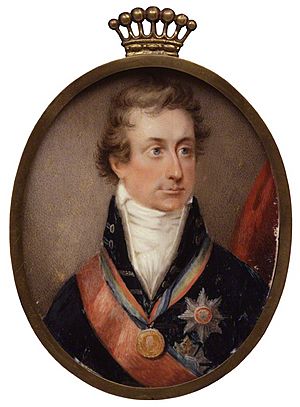William Haines (artist) facts for kids
William Haines (born 21 June 1778 – died 24 July 1848) was a talented English artist. He was known for his skills as an engraver and a painter.
Early Life and Learning
William Haines was born in Bedhampton, Hampshire, in 1778. When he was a baby, his family moved to Chichester, which he always thought of as his hometown. He went to school at Midhurst grammar school. While there, he saw the famous Cowdray House burn down.
After school, William became an apprentice to an engraver named Thew in Hertfordshire. He worked alongside other engravers on the large and important Boydell-Shakespeare plates. These were special engravings for the Boydell Shakespeare Gallery, which showed scenes from William Shakespeare's plays.
Adventures Abroad
In 1800, William Haines traveled to the Cape of Good Hope, which is now in South Africa. On the way, his ship was attacked by a French privateer, but they managed to fight it off!
While in Cape Town and exploring the country, he drew many pictures of the local people, like the Caffres and Hottentots. His drawings were similar to the later works of George Catlin, who drew pictures of Native Americans.
From the Cape, William went to Philadelphia in the United States. There, he engraved pictures for many books, including 'Johnson's Poets' and 'Bradford's British Classics'. He also engraved portraits of important people like Dr. Barton, Dr. Rush, Sir W. Jones, and Benjamin Franklin.
Art Career in England
William Haines returned to England in 1805 and started working in London. He began painting miniatures, which are very small, detailed portraits. This work brought him back to Chichester, where he had connections.
A writer named Hayley, for whom William had engraved a plate, became a good friend and helped him. After finishing his work in Chichester, William tried working in Southampton, but it didn't go very well.
Back in London, his career improved. He started painting on a larger scale and eventually began painting in oils. From 1816 to 1830, he lived and had a studio at 1 Boyle Street, London. Many important people came to him for miniature portraits, including:
- Lord Strangford
- Lord Portarlington
- Lord Fitzroy Somerset (who later became Lord Raglan)
- Sir Andrew Barnard
- Other officers from the Peninsula War
- Earl Stanhope
- Sir Charles Forbes
- Baron Garrow
- Legh, the traveler
- Salamè, an interpreter
- Lady Anne Barnard
- The Misses Porter
- Moore
- Theodore Hook
- Miss Stephens
He also painted oil portraits of Buchanan McMillan and Captain (Sir E.) Parry. These oil paintings were later engraved by another artist named Reynolds.
Later Life and Passing
William Haines retired to East Brixton. He passed away there on 24 July 1848, at the age of 70.


